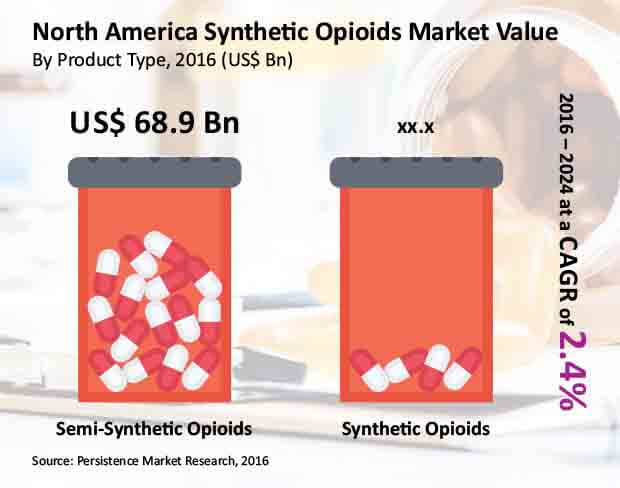Demand for synthetic opioids continues to witness a decline in North America. According to a new research from Persistence Market Research, the US$ 75 billion synthetic opioids market will grow at a sluggish 2.4% during the period 2016-2024.
Rising concerns about the addictive nature of opioids, combined with drug abuse has led to declining sales. According to the Centers for Disease Control and Prevention (CDC) around 33,000 Americans died from opioid overdose in 2015. The agency also reported that almost half of non-cancer patients who have been prescribed opioids for a month are still dependent on the pills a year later. Further, side effects of synthetic opioids, such as reduce libido, urinary difficulties, appetite loss, and spells of dizziness are also influencing sales negatively.
Get Sample Copy of this Report@ https://www.persistencemarketresearch.com/samples/15898
According to Persistence Market Research, introduction of non-abuse opioid drugs and drug exclusivity for branded options are the opportunities for pharmaceutical companies.
- Purdue Pharma LP
- Pfizer Inc.
- Janssen Pharmaceuticals, Inc.
- Teva Pharmaceuticals
- Endo International plc
- West-Ward Pharmaceuticals (Hikma’s US subsidiary)
- Mallinckrodt Pharmaceuticals plc
- Mylan N.V.
- Impax Laboratories, Inc
- Indivior Plc.
- Others.
Request for Methodology@ https://www.persistencemarketresearch.com/methodology/15898

Key Trends
- Leading pharmaceutical companies are partnering with pain management service providers to boost sales.
- Focus on developing non-addictive variants is growing, with leading players altering their packaging and drug formulation.
- Pharmaceutical companies are promoting their novel products to cut down competition from generic manufacturers.
- The Drug Enforcement Administration’s plan to reduce the amount of Schedule II opioid pain medication manufactured in the U.S. by 25% can significantly impact sales in foreseeable future.
Persistence Market Research’s study on the North America synthetic opioids market revealed that only 18% of opioids are obtained from licensed physicians. The report also found that increasing government regulations and DEA cuts can reduce unauthorized access.
By product type, the report has segmented the market into synthetic opioids and semi-synthetic opioids. Semi-synthetic opioids continue to witness heavy demand, accounting for nearly 92% value share in 2016. By sales, highest-selling semi-synthetic opioids are hydrocodone, oxycodone, and buprenorphine.
Access Full Report@ https://www.persistencemarketresearch.com/checkout/15898
Pain management remains the dominant application of synthetic opioids, accounting for over 90% revenue share of the market in 2016. Valued at over US$ 67 billion in 2016, use of synthetic opioids for pain management is expected to grow at 2.3% CAGR through 2024.
Retail outlets remain the dominant application segment for synthetic opioids, accounting for nearly 66% revenue share in 2016. Availability of synthetic opioids in retail outlets will continue to influence sales. By 2020, US$ 55 Bn worth of synthetic opioids will be sold through retail outlets in North America.
The U.S. remains at the forefront of global demand for opioids; unsurprisingly, it dominates the North America synthetic opioids market. Canada’s revenue share – 9.9% in 2016 – is projected to reach 10.6% by 2026.
